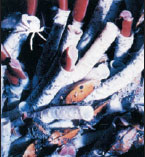Animal Ecology
 |
The lavish richness of the earth’s biomass is organized into a hierarchy of interacting units: an individual organism, a population, a community, and finally an ecosystem, that most bewilderingly complex of all natural systems. Central to ecological study is the habitat, the spatial location where an animal lives. What an animal does in its habitat, its profession as it were, is its niche: how it gets its food, how it arranges for its reproductive perpetuity—in short, how it survives and stays adapted in the Darwinian sense. A niche is a product of evolution and once it is established, no other species in the community can evolve to exploit exactly the same resources. This illustrates the “competitive exclusion principle”: no two species will occupy the same niche. Different species are therefore able to form an ecological community in which each has a different role in their shared environment.
In the mid-nineteenth century, the German zoologist Ernst Haeckel introduced the term ecology, defined as the “relation of the animal to its organic as well as inorganic environment.” Environment here includes everything external to the animal but most importantly its immediate surroundings. Although we no longer restrict ecology to animals alone, Haeckel’s definition is still basically sound. Animal ecology is now a highly synthetic science that incorporates everything we know about the behavior, physiology, genetics, and evolution of animals to study the interactions between populations of animals and their environments. The major goal of ecological studies is to understand how these diverse interactions determine geographical distributions and abundance of animal populations. Such knowledge is crucial for ensuring continued survival of many populations when their natural environments are altered by human activity.




